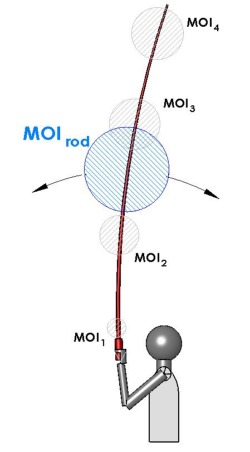 1 Introduction
1 Introduction
The term "swingweight" (or "swing weight") is well established in many sports which use a bat, club or racquet. In those sports, swingweight means the moment of inertia around a predetermined axis. We use the term swingweight to mean the moment of inertia of a single handed fly-rod around an axis at the butt of the rod. This standardizes usage and distinguishes swingweight from the moment of inertia around any other axis { particularly around the center of mass.
Moment of inertia (MOI) is resistance of an object to rotational acceleration. Greater MOI requires more torque to achieve the same rate of angular acceleration. So, the greater the MOI of a fly-rod the more force (torque) is needed to cast or manoeuvre that rod.
MOI is strongly dependent on mass distribution and distance from the axis of rotation. The dependence on distance from the axis is quadratic, so MOI increases with the square of distance to the axis of rotation. The following will generally be true:
- Long rods will have higher MOI than shorter rods of similar build and/or mass.
- Mass in the tip of the rod is much more important than the mass in the lower part of the rod (reel seat and grip).
- Rods with heavy blanks will have higher MOI than rods with light blanks.
This note is organized as follows. In Sec. 2 we present a method to calculate realistic swingweight values for multi-piece fly-rods. Sec. 3 gives a "cook-book" recipe for measuring and calculating fly-rod swingweight. Sec. 4 gives sample findings for 3 and 4 piece rods and we conclude in Sec. 5. For interested readers, we have included more detailed calculations in Appendix A.
2 Fly-rod MOI
In this section we present a method to estimate the moment of inertia...
...
Read on here Measuring Fly Rod "Swingweight" (swingweight.pdf)
...
Moment of Inertia Online Calculator and data log
This calculator performs the calculations described in Sections 2 & 3 of the paper, along with providing an option to submit the data to a log file.
Grunde Løvoll
Magnus Angus
March 2008
















